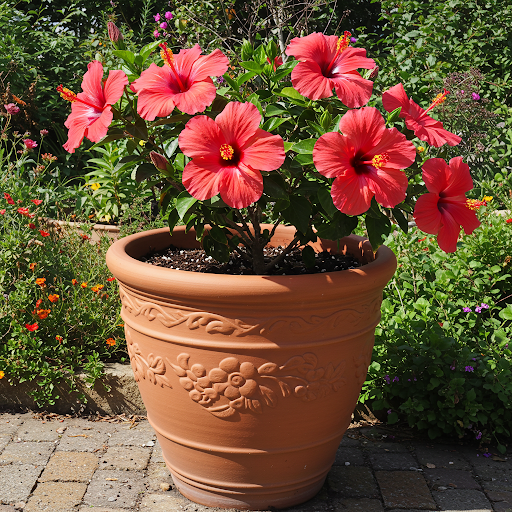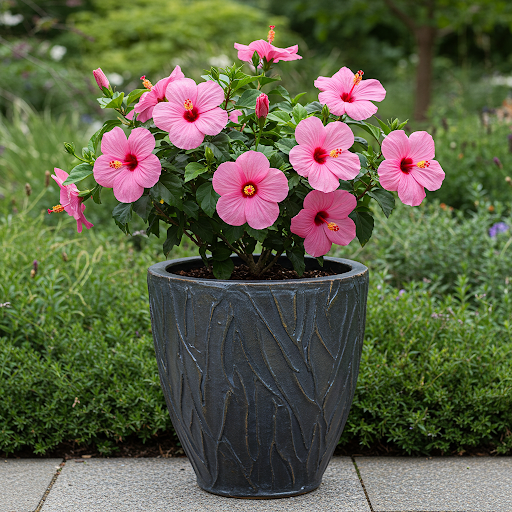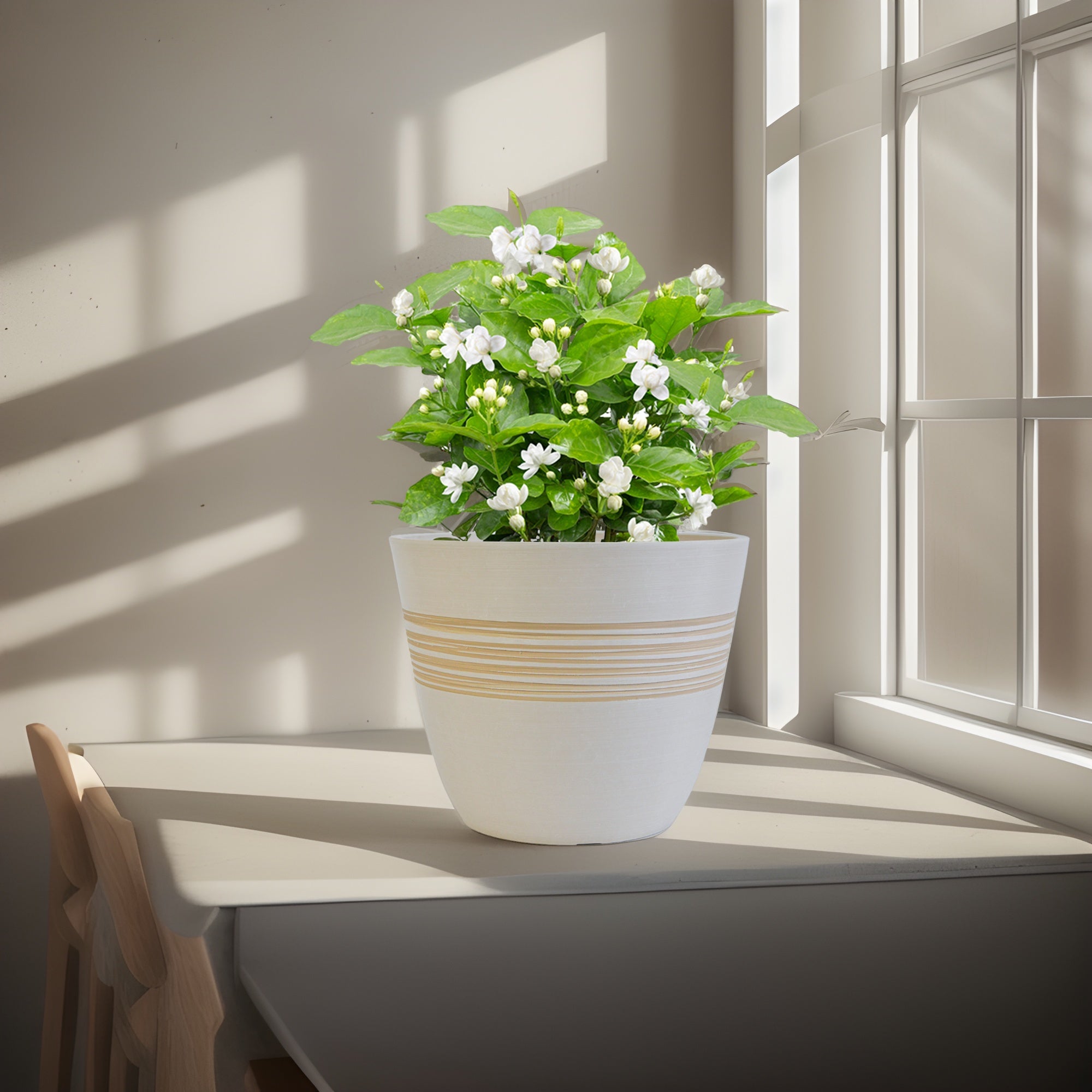Cotton Rose in Pots: The Ultimate Guide to Growing Hibiscus Mutabilis Outdoors in Containers (Color-Changing Blooms!)
Want to witness the daily color transformation of the enchanting Cotton Rose (Hibiscus mutabilis) and its unique, multi-hued blooms? Growing this fascinating hibiscus in containers is a wonderfully rewarding way to enjoy its ever-changing floral display and shrubby beauty, even in limited spaces. Celebrated for its flowers that magically change color throughout the day (starting white or pink and deepening to rose or red), its large, showy blooms, its attractive foliage, its relatively fast growth, and its adaptability to container gardening, the Cotton Rose is perfect for adding a touch of wonder and dynamic color to your outdoor living areas. This comprehensive guide will provide you with everything you need to know to grow Hibiscus mutabilis successfully in outdoor pots, from understanding its color-changing flowers and selecting the best containers to mastering essential care techniques for a captivating and ever-evolving floral spectacle.

Cotton Rose
What is the Cotton Rose?
The Cotton Rose, scientifically known as Hibiscus mutabilis, is a deciduous shrub or small tree belonging to the Malvaceae family (Mallow family), the same family as other popular hibiscus and garden plants like hollyhocks and okra.1 Native to China, it is widely cultivated as an ornamental plant around the world, especially in warm temperate and subtropical climates, prized for its unique color-changing flowers, large, showy blooms, attractive foliage, and relatively easy care.2 Hibiscus mutabilis is characterized by its upright, bushy growth habit, its large, lobed, maple-like leaves, and its spectacular flowers that are its most distinguishing feature. The flowers are large (4-8 inches in diameter), hibiscus-like in form, and exhibit a remarkable color transformation throughout the day.3 They typically open white or light pink in the morning, gradually deepening to rose pink by midday, and finally turning a rich, deep red or crimson by late afternoon or evening, all on the same plant at the same time, creating a multi-colored display.4 This color change is due to changes in pigment chemistry within the petals as the day progresses. Flowers can be single or double, depending on the variety, and bloom profusely from late summer into fall.5 The plant itself is a relatively fast grower and can reach heights of 8-15 feet (2.4-4.5 meters) or more in the ground, but stays more compact in containers.6 Cotton Rose is known for its magical color-changing blooms, its long blooming season, its association with mutability and change, its ease of cultivation in warm climates, and its ability to bring a sense of wonder and dynamic beauty to any garden setting.7
Is the Cotton Rose Good for Outdoor Pots?
Yes, the Cotton Rose is very well-suited for outdoor pots and container gardening, and is a popular choice for patios, balconies, and other outdoor areas.8 Container growing is an excellent way to manage its size, enjoy its unique blooms up close, and move it to optimal locations as needed. Its adaptability to container culture, manageable size in pots (especially with pruning), spectacular color-changing flowers, attractive foliage, and relative ease of care make it ideal for container cultivation. Growing Cotton Rose in pots offers several advantages:
- Ideal for Patios and Balconies: Container gardening allows you to enjoy the Cotton Rose even if you have limited garden space, such as on balconies, patios, or decks.9 They bring vertical interest and unique floral beauty to paved areas.
- Portability: Potted Cotton Rose plants can be easily moved to optimal locations for sunlight, display, or shelter from extreme weather. You can rearrange them to create stunning focal points or seasonal displays. Bring them indoors to protect from frost in colder climates if needed, or to overwinter in a sheltered location.
- Controlled Soil Conditions: Container gardening allows you to provide the specific well-draining, fertile soil mix that the Cotton Rose prefers and control watering and fertilization more precisely, which is important for its health and flowering.
- Design Versatility: Cotton Rose in pots can be used as standalone specimen plants in decorative pots, placed in pairs flanking doorways or entrances, grouped together for a massed display of color, or used to create a focal point in a container garden arrangement. Their upright, shrubby form and unique blooms add a touch of elegance and dynamic beauty to container gardens.
- Size Control: Container growing naturally restricts the size of the Cotton Rose, making it more manageable for smaller gardens and preventing it from becoming too large, which can be beneficial as it can be a vigorous grower in the ground.
- Pest and Disease Management: Container growing can help reduce some soilborne pest and disease issues that can affect Cotton Roses planted directly in the ground.
- Highlighting Unique Blooms: Container growing allows you to bring the fascinating color-changing flowers up close for easy observation and enjoyment of their daily transformation.
Ideal Growing Conditions for Cotton Rose in Pots:
Types of Cotton Rose (Varieties and Flower Forms): While Hibiscus mutabilis is the main species grown for its color-changing flowers, you might find variations primarily in flower form (single or double):
- Single-Flowered Cotton Rose: The typical Hibiscus mutabilis has single, saucer-shaped flowers that clearly show the color transformation.10
- Double-Flowered Cotton Rose: Some varieties or plants may have semi-double or fully double flowers, which are more densely petaled and rose-like in appearance. Double forms may sometimes be labeled as Hibiscus mutabilis ‘Plena’ or similar. Double flowers can be very showy and long-lasting.
- Pink or White Starting Colors: Most Cotton Roses start with white or light pink flowers in the morning, but the intensity of the initial pink and the final red color can vary slightly. Choose based on your preferred color palette.
Light: Cotton Roses thrive in full sun.11 They need at least 6-8 hours of direct sunlight per day, and ideally more, to bloom profusely and develop their best flower color transformation. When grown in pots outdoors, position them in the sunniest location possible in your garden or patio. They will tolerate very light afternoon shade, but full sun is best for optimal flowering and vibrant colors. Insufficient sunlight will result in fewer flowers and less intense color changes.
Soil: Cotton Roses prefer well-draining, fertile soil that is slightly acidic to neutral. Use a high-quality general-purpose potting mix. Amend potting mix with compost, well-rotted manure, and perlite or vermiculite to improve fertility, drainage, and aeration. Good drainage is essential to prevent root rot, especially in containers.12Cotton Roses are adaptable to a range of soil types but thrive in well-drained, fertile conditions. A slightly acidic to neutral pH (around 6.0-7.0) is ideal.
Watering: Cotton Roses prefer consistently moist soil, especially during the growing season and when blooming, but they don’t want to be waterlogged.13 Water thoroughly when the top inch of soil feels slightly dry. Water deeply until water drains out of the drainage holes. Then, allow the topsoil to slightly dry before watering again. Avoid overwatering and consistently soggy soil, which can lead to root rot. Also, avoid letting the soil dry out completely, especially when plants are actively growing and blooming. Cotton Roses prefer a “moist but not soggy” soil environment. Watering frequency will depend on weather conditions, pot size, and the plant’s growth stage. Water more frequently during warmer, drier periods and less frequently during cooler, cloudier periods and in the dormant season (winter). Reduce watering in winter after leaves have dropped, but don’t let the soil dry out completely.
Temperature: Cotton Roses are warm-climate plants and thrive in hot summers and mild winters. They are hardy in USDA zones 7-10, and are well-suited to tropical and subtropical climates like Singapore.14 They are very heat-tolerant and bloom best in warm to hot weather. Protect from frost and freezing temperatures if growing in colder climates (not a concern in Singapore).
Humidity: Cotton Roses are adaptable to a range of humidity levels and tolerate both moderate and high humidity. Singapore’s humidity is generally well-suited to Cotton Roses.
Fertilizer: Cotton Roses are moderate to heavy feeders and benefit from regular fertilization, especially when young and when grown in containers, to support their vigorous growth and abundant flowering. Fertilize every 4-6 weeks during the spring and summer growing season (active growth and bloom period).15 Use a balanced liquid fertilizer (e.g., 10-10-10 or 20-20-20) or a fertilizer specifically formulated for flowering shrubs or hibiscus. Follow product label instructions for application rates. A fertilizer slightly higher in phosphorus (the middle number) can encourage better flowering. You can also amend the potting mix with slow-release fertilizer granules at planting time for a season-long feeding. Reduce or stop fertilizing in late summer or fall as growth naturally slows down.
Choosing the Right Pots for Cotton Rose:
Suitable Pot Types: Cotton Roses can be grown in various pot types, but good drainage, stability, and appropriate size are important. Suitable pot types include:
- Terracotta Pots: Terracotta pots are a good choice as they provide good drainage and aeration, helping to prevent overwatering, and offer a classic, natural look that complements Cotton Roses. Larger terracotta pots are needed for mature plants.
- Ceramic Pots (Glazed or Unglazed): Glazed or unglazed ceramic pots can be used, offering a wide range of decorative styles. Ensure they have drainage holes and are large and sturdy enough for a shrub. Choose based on your desired aesthetic and pot size needs.
- Resin Pots (Large and Durable): Large, durable resin pots are a good option as they are lighter than concrete or large terracotta, but can still be made very large and robust, and are durable for outdoor use. Choose UV-resistant resin pots designed for shrubs or small trees.
- Plastic Pots (Sturdy, Dark Colors): Sturdy, good quality plastic pots can be used, especially for larger plants, as they are lightweight and durable.16 Ensure excellent drainage. Dark-colored plastic pots can help retain soil warmth.17
Drainage: Good drainage is essential for Cotton Roses to prevent root rot.18 Ensure your chosen pot has drainage holes at the bottom. Avoid pots without drainage holes. Always use a drainage layer at the base of the pot (e.g., a layer of gravel or pot shards) beneath the potting mix to further enhance drainage, especially in larger pots. Elevating pots slightly on pot feet or bricks can also improve drainage and air circulation.19
Pot Size: Choose pot sizes appropriate for the size and maturity of your Cotton Rose plant and your desired display. Cotton Roses have moderately deep root systems and need room for root development and shrub growth.
- Young Plants or Small Shrubs: Start with pots that are at least 12-14 inches in diameter and depth.
- Mature Shrubs (Medium-Sized): Use pots that are 16-20 inches in diameter and depth or larger.
- Larger, More Mature Specimens: Pots that are 20-24 inches in diameter and depth or larger can be used for very mature, larger plants. For very large, mature specimens, you might even need pots that are 24 inches or more in diameter.
- Depth: Pots should be at least 12-16 inches deep, and ideally 16-20 inches deep or more for larger varieties, to accommodate the root system and provide good soil volume for shrub growth.
Stability: For larger Cotton Rose shrubs, using moderately heavy pots (terracotta or ceramic) can provide good stability, especially as they grow taller and become bushier, and in windy locations. Wider pots are generally more stable than tall, narrow pots.20
Color and Style: Choose pot colors and styles that complement the flower colors and lush foliage of your Cotton Roses and your outdoor décor, and enhance their vibrant, tropical appearance. Classic terracotta, earthy tones, or brightly colored pots can create a warm and inviting look, highlighting the colorful, ever-changing blooms and green foliage. Consider the overall style of your patio or balcony and choose pots that harmonize with the surroundings and enhance the desired colorful, dynamic garden ambiance.
Essential Care Tips for Thriving Cotton Roses in Outdoor Pots:
- Watering: “Keep Soil Consistently Moist During Growing Season, Allow Top Inch of Soil to Slightly Dry Between Waterings”. Water thoroughly when top inch of soil is slightly dry during growing season. Water deeply and ensure good drainage. Allow topsoil to slightly dry between waterings. Avoid overwatering, especially in winter dormancy.
- Sunlight: Provide Full Sun (at least 6-8 Hours Daily for Best Bloom and Color Change). Full sun is essential for abundant flowering and vibrant color transformation.21
- Fertilizing: Fertilize Every 4-6 Weeks During Growing Season with Balanced Liquid Fertilizer.22 Fertilize regularly during the spring and summer growing season to promote healthy growth and flowering.23 Use a balanced liquid fertilizer or flowering shrub fertilizer. Reduce or stop fertilizing in late summer/fall.
- Pruning (Light to Moderate Pruning in Late Winter/Early Spring): Cotton Roses benefit from light to moderate pruning in late winter or early spring before new growth begins.24 Prune to shape the shrub, remove dead or crossing branches, and control size. You can also lightly prune after the main bloom season to encourage a later flush of flowers.
- Deadheading (Encourage Continued Bloom): Deadheading spent flowers (removing faded blooms) is not strictly necessary, but it can improve the plant’s appearance and may encourage slightly prolonged blooming by preventing seed pod formation.
- Pest and Disease Control (Generally Low Maintenance): Cotton Roses are generally relatively pest and disease-resistant. Monitor for aphids, spider mites, or hibiscus beetles occasionally. Treat with appropriate insecticides if needed. Ensure good air circulation to prevent fungal diseases, especially in humid climates.
- Winter Care (Minimal Care in Singapore, Protect from Frost in Colder Climates): In Singapore’s climate, no winter protection is needed. In colder climates (outside of zones 7-10), potted Cotton Roses may benefit from winter protection. Move pots to a sheltered location (garage, unheated greenhouse) or provide insulation to the pot and shrub to protect from freezing temperatures and frost. Reduce watering significantly in winter dormancy.
- Repotting (Every 2-3 Years or as Needed): Container-grown Cotton Roses will need repotting every 2-3 years, or when they become root-bound, into progressively larger pots. Repot in late winter or early spring before new growth begins. Refresh the potting mix at repotting time. For very large pots that are difficult to repot, top-dress with fresh potting mix annually.
Popular Cotton Rose “Cultivars” (Variations within Hibiscus mutabilis Species):
As mentioned, variations in Hibiscus mutabilis are mainly in flower form (single or double).25 Look for:
- Single Flowered Hibiscus mutabilis: The standard species form, showcasing the color change clearly.
- Double Flowered Hibiscus mutabilis ‘Plena’ (or similar): For a more rose-like, densely petaled flower form.
Choose based on your preferred flower appearance. Both single and double forms exhibit the characteristic color transformation.
In Summary:
Growing Cotton Rose (Hibiscus mutabilis) in outdoor pots is a wonderfully rewarding way to experience the daily magic of their color-changing blooms and enjoy their lush, shrubby beauty in your outdoor spaces. Their spectacular and ever-evolving flowers, attractive foliage, and adaptability to containers make them a perfect choice for container gardeners of all levels, especially those seeking unique, colorful, and relatively easy-care flowering shrubs for patios, balconies, and gardens. By providing full sun, well-draining potting mix in pots with good drainage, regular watering and fertilization during the growing season, and choosing pot sizes appropriate for their growth, you can easily cultivate thriving and spectacularly blooming Cotton Rose plants in pots and enjoy their dynamic floral displays and captivating color transformations in your outdoor living areas for many years to come.

Cotton Rose
For more detailed botanical information and to explore the enchanting world of Cotton Roses, you can visit the Wikipedia page on Hibiscus mutabilis.
Important Note: The magic of the Cotton Rose is in its daily flower color transformation! Plant them in a sunny spot, provide consistent moisture and fertilizer, and you will be rewarded with the captivating and ever-changing beauty of these unique hibiscus blooms in your container garden!
k2-21G
By greenship|2024-08-13T06:17:26+00:00August 13, 2024|Categories: Hand-carving Series|
Planter 6 in W / 8 in W / 12 in W Indoor or Outdoor Plants, Modern Decorative Plant Pots with Drainage Hole, Decorative Flower Pots
By greenship-seo|2025-02-06T13:43:53+00:00January 16, 2025|Categories: Hand-carving Series|Tags: Decorative Flower Pots|
20VD
By greenship|2024-08-13T06:43:41+00:00August 13, 2024|Categories: Hand-carving Series|
Planter for Indoor Outdoor Plants, Set of 2 Modern Decorative Plant Pots with Drainage Hole, Decorative Flower Pots
By greenship-seo|2025-04-10T07:46:01+00:00January 9, 2025|Categories: Hand-carving Series|Tags: Decorative Flower Pots, Self-Watering Pots|
KC2-11V
By greenship|2024-08-16T05:39:50+00:00August 16, 2024|Categories: Hand-carving Series|
11TH
By greenship|2024-08-13T02:50:25+00:00August 13, 2024|Categories: Hand-carving Series|






